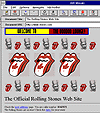


 accesses since April 2, 1996
accesses since April 2, 1996 copyright notice
copyright notice



 accesses since April 2, 1996
accesses since April 2, 1996
The term "cyberspace" originated with science fiction novelist William Gibson's Neuromancer. Since that time, it has taken on a life of it's own. Although overworked, it remains the most popular descriptor of the networked universe in which many of us now work and play.
Cyberspace is a digital Einsteinian universe: a finite but unbounded information cloud. It is a conceptual collage where the world's information resources come together seamlessly. There is nothing physical - everything is virtual. With one click of the mouse button one creates a virtual window into this cloud of virtual information. There is no surface topology to this cloud and no geographical features beneath to give us a sense of direction. This is a truly exciting environment!
For this artificial reality, we are indebted to a few pioneer computer scientists with a vision of what might be possible with digital networks - networks in the abstract rather than physical sense of the term. This is not to imply that the physical aspects of digital networks are less important. It is just that cyberspace really evolved from the softer side of things.
 The physical side of the unifying digital common carrier is the
wide area network (WAN). This is not cyberspace. For
cyberspace, the digital common carrier needs virtuality.
The physical side of the unifying digital common carrier is the
wide area network (WAN). This is not cyberspace. For
cyberspace, the digital common carrier needs virtuality.
Of the three original bread-and-butter Internet applications - electronic mail, file transfer protocol (ftp), and remote login (Telnet) - only Telnet contributes to virtuality. Without that first step, digital networks would not have evolved beyond the level of lifeless communications facilitating devices. Telnet created the possibility of a virtual terminal, and that ushered in the world of Internet client-server technology.
From all appearances, Telnet is an unlikely candidate for such honors. In this case appearances are deceiving. Figure 1 illustrates the point. This is a Telnet session where Telnet client software (in this case Air Telnet from Spry Corporation) is run from a Win-OS/2 session connecting the workstation to a local Unix server (cavern.uark.edu). From "cavern" another Telnet connection is made to yet a third server in Texas (acm.org). From this third server a Unix network browser program called Lynx is run interactively. From the user's point of view it is as if Lynx were running on the Win-OS/2 client. In this one session, a Unix program from a distant computer is being run interactively on a non-Unix workstation via indirect routing over the Internet. Life is grand.
 Telnet is the genesis of cyberspace. Telnet was the first
general-purpose, client-server technology to be used with the
Internet. One could run programs anywhere in the world as if
they were on a local computer irrespective of any differences in
the computer environments. This spatial and environmental
transparency showed how it was possible to bring the world's
computing resources together in a seamless whole.
Telnet is the genesis of cyberspace. Telnet was the first
general-purpose, client-server technology to be used with the
Internet. One could run programs anywhere in the world as if
they were on a local computer irrespective of any differences in
the computer environments. This spatial and environmental
transparency showed how it was possible to bring the world's
computing resources together in a seamless whole.
From Telnet, it was a short technological leap to client-server "navigation and browsing" utilities. With navigation utilities, one could conveniently sail through cyberspace without regard to the topology of the network. With browsing, one could partake of the immense information resources wherever they resided. Where Telnet unified the world's computers, navigation and browsing programs unified the information which they contained. Cyberspace was born.
Navigation and browsing utilities may be categorized by the underlying protocols adopted by the client-server programs which support them. These protocols establish the format of the menus used, the conventions for file and text searches, the range of media supported (text, graphics, audio, video) and so forth. Within each category there are several different program families. For example, Veronica and Jughead are file location services available for the Gopher protocol. Mosaic and Cello are navigation/browsing programs which conform to the World Wide Web protocol. (see Figure 2) Some services (e.g., Archie) are stand-alone and not dependent upon any particular protocol.
 Browsing and navigating capabilities are typically bundled
together in a single product because they are both needed to surf
cyberspace. They are the basic tools of cyberspace.
Browsing and navigating capabilities are typically bundled
together in a single product because they are both needed to surf
cyberspace. They are the basic tools of cyberspace.
Less general, though no less useful, are tools for virtual file organization (Prospero), checking logon lists (Finger), directory services (Whois, X.500), to name but a few. I would estimate that there are well over 100 cyberspace tools available to the cybernaut today.
In the future, new programs and protocols will be added to fulfill each new and pressing need for cyberspace access. The next breakthrough in cyberspace services will be information agency auto-navigating programs will act as the cybernaut's agent in locating and retrieving information. Progress is well underway with programs called spiders, worms and wanderers which migrate through cyberspace collecting information on available resources.
Stay tuned for the genesis of cyberspace, part deux, in the next issue of PC AI. In the meantime, get connected. The Rolling Stones are, and so is the Petry family.